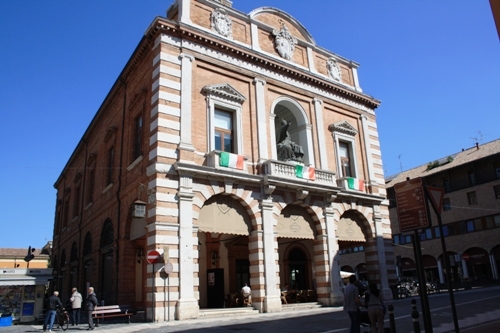Itineraries:
Cesena: the city of the three Popes

Cesena, amministrative centre of the territory of Forlì-Cesena, is a renowned university town with an enviable cultural heritage and also location of the
Malatesta Library, one of the rare examples of humanistic library - dating back to 1454.
Benedict XIII
Cesena, is also known as City of the Three Popes, In reality two of them were born in Cesena, instead one was only the Bishop of the city, then elected Pope with name of
Benedict XIII.
Before becoming pope Pietro Francesco Orsini from Gravina di Puglia, was appointed Bishop of Cesena 1680, but remained in Romagna only six years before being transferred to the seat of an archbishop of Benevento.
Two powerful local families
The other two Popes,
Pius VI and
Pius VII belonging to important and powerful local families (that of Braschi and Chiaramonti). They left an indelible mark on the world, not only locally, but in the whole history of the Italian artistic heritage. They lived in the age of Napoleon Bonaparte, ruled between torment and were imprisoned in the period between the outbreak of the French Revolution, the fall of Napoleon and the Congress of Vienna ...
Pius VI and Pius VII
Two Popes who succeeded themselfs to the papacy: the death of Pius VI in 1799 in exile in Valence succeeded, in 1800, Pope Pius VII Chiaramonte. In the periodo f their regency were established the Vatican Museums from the Museum of Pio Clementino. During the pontificate of Pius VII was also approved the first law of preservation of historic and artistic heritage, today still a point of reference to the legislation of Italy.
In Cesena, you can find traces of the two pontiffs through some places visited.
The places of the Popes
Pius VI (Giannangelo Braschi; Cesena, December 25, 1717 - Valence-sur-Rhône, August 29, 1799) was solemnly immortalized on the facade of the
Palazzo del Capitano del Popolo, better known as the
Palazzo del Ridotto, where stands his bronze statue created by Francesco Calligari and placed there only in 1792, but conceived when the Pope himself journeyed from his native town after returning from trip to Vienna, during which he had met with the Emperor Joseph II. The front of the Palazzo brings together the insignia of the noble family Braschi, an inscription that refers explicitly to the greeting addressed from Cesena to the Pope. On that occasion Pope Pius VI crowned the fresco of the
Madonna del Popolo kept at the Cathedral of
St. John the Baptist and completed in 1520 by the painter Giovan Battista Ramenghi called Bagnacavallo, work which he had also made many miracles arousing a great popular devotion.
Still referring to Pius VI, kept at the
Malatesta Library is a beautiful parade bat that the Pope himself gave to the city of Cesena.
To retrace the events of the successor and luckier Pius VII (Barnaba Niccolò Maria Luigi Chiaramonte Cesena 14/08/1742 - 08/20/1823 Rome), there should be a visit to the
Abbazia del Monte di Cesena. Resting on the hill Spaziano, the Benedictine Abbey was founded by the bishop of the city of Cesena, San Mauro who had found a place of meditation around the tenth century. The abbey was enlarged considerably between the fifteenth and eighteenth centuries. Among the various nobles who enter as novices in that place there was also the Count Barnaba Chiaramonte, in 1756, the future Pope. This great man of learning was a fine collector of books; had collected about 5,500 books in life including rare
incunabula,
cinquecentine and books from the fifteenth to the nineteenth century.
The Pope had left in ihis testament the impressive collection at the Abbey but in reason of a formal defect, the collection was located at the local Malatesta Library, where it is still visible. The "Library Piana" contains a Gospel manuscripts dated 1104, a legal code with the
Decretum Gratiani of the thirteenth century, a Roman missal with a beautiful miniate crucifixion. Among the incunabula we can remember a copy of Ptolemy's Cosmographia with the false date of 1462 (printed in 1477 or perhaps in 1482), with colored plates, attributed to Taddeo Crivelli.
The Church of Santa Cristina
The papal itinerary in Cesena ends with an extraordinary place of spirituality. It is the
Church of Santa Cristina, in Chiaromonti street.
There are traces of this church since the Middle Ages, but it was abandoned in the XV century. Then in 1470 and 1630 was built again. A new arrangement was conducted in 1740 by Giovanni Francesco Zondini, who designed a longitudinal slot with three altars. In the mid-eighteenth century was donated to the church the body of Santa Cristina, found in the Roman catacombs of San Callisto.
In 1814 Pius VII stopped at Cesena to return from the captivity in Fontainebleau and undertook to finance the construction of the new church, which overlooks along the same street of the Chiaramonti’s palace. The building site began in 1816, but the financing was barely only for the construction of the underground, interesting and rare example of a circular room covered by a lowered sferical cap. Despite the attempt of the Pope to reduce spending by giving a new project to Benedict Barbieri, the design of Valadier was finished with small variations. The work was carried out in 1825. Already in 1806 the church had lost the title of parish, while remaining open to worship. Today it is regularly officiated in the festivities and visited on request (ring at the sacristy). It has been restored since 1981.
Apri la mappa dettagliata